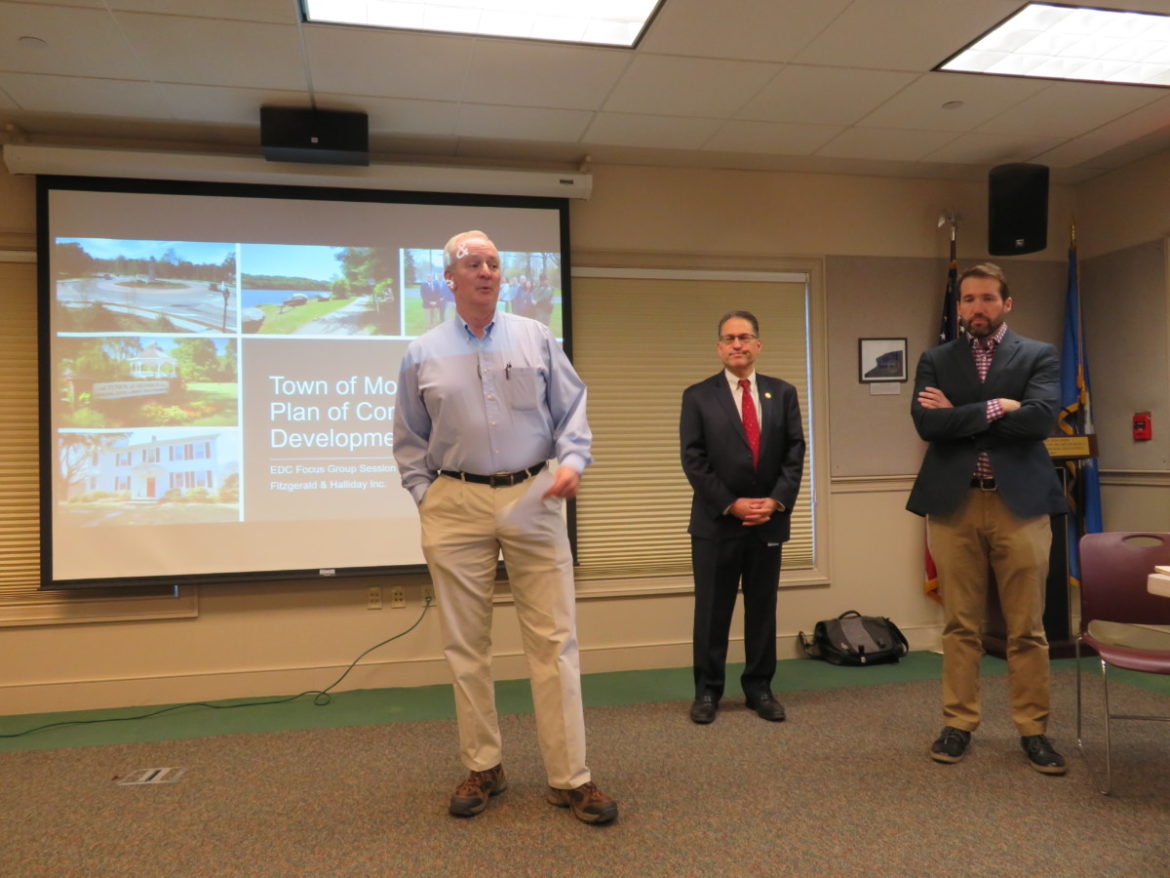MONROE, Conn. — Monroe’s “archaic” zoning regulations can make it difficult for Planning and Zoning commissioners and land use staff to approve applications, even when they want to say, “yes,” according to John Kimball, a local developer.
“The problem is the legal way the zoning regulations are written,” Kimball said. “It’s like having a car with square wheels in your driveway. Some people have a fear, if they open up our regulations, of what will come here. But other communities have and nothing bad happened.”
“Our regulations are archaic, outdated and need to be thrown out,” he continued. “It’s not the uses, it’s how the structure is done. This is a tremendous undertaking, but it would be worth it.”
“It’s not so much that it’s archaic,” said Kevin Solli, a civil engineer with Solli Engineering, adding it is the onerous way the regulations are written with too many definitions and subsections.
Franciso Gomes of Fitzgerald & Halliday, Inc., the consultant hired by the town to assist the Planning and Zoning Commission with the update of Monroe’s Plan of Conservation and Development, which guides its zoning regulations, wants to start by simplifying the POCD.
“We want to do a little more than an update,” Gomes said of the plan. “We want to redo it and make it more user friendly. We want to establish a vision for your priorities and goals. We’ll also provide an implementation plan with a list of things to do.”
Close to 40 people attended a POCD breakfast in the Ehlers Room of Edith Wheeler Memorial Library last week, as work continued on the update, which the state requires to be done every 10 years.
The meeting focused on business and industry.
Fitzgerald & Halliday was planning a workshop to gather more public input in April, but the coronavirus pandemic may push that back. The firm was also close to releasing a town-wide survey.
“Once we conclude this public communication effort, the goal is to take it to a hearing and approve it by the end of the year,” Gomes said.
Statistics and trends
Gomes said Monroe’s population of just over 20,000 people experienced its most growth in the 1970s, ’80s and ’90s, though it has been marginal since 2000 with a total of 500 new residents.
There was a population loss of young residents (below the age of 10) and residents age 35 to 49 between 2010 and 2017, according to statistics in his presentation.
Gomes said Monroe has lagged behind Fairfield County in population growth since 2000. “It’s really people and population that drive economic development,” he said.
“Monroe has a very high median household income, which bodes well for economic development,” Gomes said, adding Monroe has relatively diverse economic industry for a town of its size.
The median household income of $109,631 in Monroe is 22 percent higher than Fairfield County’s ($89,773) and 49 percent higher than the state’s ($73,781).
According to information Gomes shared:
- Monroe has a higher share of resident employment than Fairfield County and the state in public administration, professional, scientific and management, and manufacturing.
- The town has the greatest share in jobs in accommodation and food services, retail trade, wholesale trade, manufacturing and construction.
- Monroe residents live in closer proximity to work than other residents in Fairfield County and the state, with 85 percent living within 24 miles.
“Most residents live within 10 to 24 miles of work,” Gomes said. “People are likely moving and staying in Monroe, because of the proximity to work.”
Residents’ commuting destinations are also diverse and include Bridgeport, Shelton, Trumbull, Stratford, Milford, Ansonia, Derby and West Haven to name a few communities. “Your residents are working everywhere,” Gomes said.
Monroe’s grand list of taxable income is 86 percent residential and 13 percent commercial, according to Gomes. Its net grand list contracted by 4 percent since 2011 and the town’s mill rate increased by 26 percent over the past decade.
He said 9.5 percent of Monroe’s land is zoned commercial or industrial and 90.5 percent is zoned residential.
Monroe’s strengths
Gomes asked what Monroe’s strengths are and Patrick O’Hara, the town treasurer and the former chairman of the Planning and Zoning Commission, said location. “We have some of the smallest commuter distances and people can come back and shop in Monroe,” O’Hara said.
Michael O’Reilly, vice chairman of the Planning and Zoning Commission, said Monroe has opportunity to grow its economy with space to build in its industrial park and vacancies in the commercial corridor.
“Your commercial land is performing slightly more per acre than residential,” Gomes said. “It means that land can do more for your economic revenue.”
“At least half is zoned zoned commercial-industrial, but is watershed land and is not buildable,” Kimball said.
Based on that, Gomes the zoning information may need to be reworked.
Everything needs a special permit
O’Hara said Monroe is pretty defined with its industrial and commercial zones.
Gomes asked if residents are happy with the way their town is zoned and just want more flexibility.
“I think there needs to be a shift in the underlying framework of zoning,” Kimball said. “Everything is a special exception use. You can’t do anything without a regulatory process.”
O’Hara said development is allowed on 25 percent coverage of a one acre residential parcel, but if he bought a one-acre commercial property and wanted to build on 25 percent of the site, he would need a special exception permit.
“Why is everything a special exception permit?” O’Hara asked. “And why is it special? There are communities who allow you to build on a lot without a special exception permit. Why can’t we?”
Redevelopment, housing
Kimball said building costs are up, so it may be a time to repurpose some of the buildings Monroe has. “We’ve been working with the town on the redevelopment of Stevenson Lumber,” he said.
Instead of being limited by current zoning to create a downtown area, Barbara Fahr, one of the moderators of the Monroe, CT Residents Facebook page, said townspeople should look at it with a fresh set of eyes, assessing what they would do if there were no restrictions.
There was also talk of helping existing businesses to thrive. Mary Hall, of the Monroe Economic Development Commission, said allowing changes to facades of existing businesses can make them more attractive.
William Porter, chairman of the Planning and Zoning Commission, said businesses leave because they are not making money. “People aren’t supporting our local businesses.”
To attract new businesses townspeople want to come to Monroe, Lee Hossler, a member of the Monroe Chamber of Commerce, said the town should put packages together to market what the town has to offer.
No Trader Joe’s
Many residents have clamored for a Trader Joe’s over the years. Solli said Monroe has the affluency of the household income to attract that type of businesses, but its population isn’t dense enough for a Trader Joe’s.
“I want growth. Diversity of housing options,” he said. Aside from allowing apartments in commercial zones as mixed-use, Solli said the town should consider allowing more multi-family housing.
Jeanette Politano, a sales associate with Coldwell Banker, suggested having one-bedroom apartments with some two bedroom apartments.
“There are kids that grew up here and want to come back to town, but can’t,” she said. “I think that’s a problem. People are graduating from college and leaving the town. They’re not coming back to live here and expand. They have to have options.”
Gomes said there’s an increase in people in their 20s living in Monroe, but many are living with their parents.
“We also have the older generation who want to stay here to be near their grandchildren,” said Nicole Lupo, a member of the Monroe Economic Development Commission.
A fresh set of eyes
While deciding how to offer more diversity in its commercial zones, Politano said Monroe should consider what other towns are doing. For example, she said some towns allow puppy daycares.
Keith Romano, chairman of the Inland Wetlands Commission, suggested recreational entertainment and Lupo said sports centers could be an example.
Greg Kamedulski, president of Greg:Cornell Development LLC, said the town should allow mixed development of commercial and residential, which is a market driven approach, rather than having zones for just commercial developments.
Kimball said redevelopment does not necessarily have to be mixed-use. “It could be expanding our medical,” he said. “We’re aging.”






